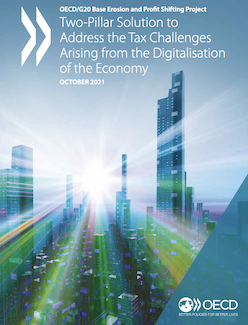
OECD Two Pillar Strategy and Tech Implications for National Tax Agencies

Guest Bloggers: Florian Breger, Vice President Civilian Global Government; Paul Dommel, Partner, Strategy and Transformation; Sharon Moore, Principal Industry Engineer, Global Government; and Mike Stone, Managing Partner Global Government, IBM
The Organization for Economic Cooperation and Development (OECD) is working with Governments to recommend a new tax paradigm that reflects the increasingly digitalized global economy. The OECD strategy would re-allocate more tax revenues to market jurisdictions where customers reside. It also would minimize tax arbitrage between different governments. These changes could have a significant impact on the way that many governments around the world manage tax collection. In turn, that will affect the technology required to administer the program.
The new paradigm, called the OECD Two-Pillar Strategy, is described below.
Pillar One: Focuses on where companies pay tax and is likely to affect a relative handful of companies and countries. OECD’s approach would lead governments to better align profits and tax revenues with where sales originate, irrespective of physical presence. At this point, OECD and countries have not settled on the specific rules and guidance to implement Pillar One. Pillar Two is more developed.
Pillar Two: Would call for a global minimum tax (GMT). Firms with revenue > €750M or about $1B will pay a GMT of 15% of profits in each country in which they operate.
- Companies would pay a “top-up tax” in their home country for the difference between the effective tax rate per jurisdiction and the 15% minimum rate.
- As currently drafted, the rules would allow countries to levy additional tax on foreign subsidiaries in country.This will occur in cases where the home country tax may be below the global minimum tax of 15%. How to prevent double taxation of the same income, where countries may claim such a top-up tax, remains to be addressed.That will be the subject of dispute prevention and resolution measures to be defined.
Originally targeted for implementation in mid-2023, that date is likely to move back as OECD and countries are continuing to develop greater clarity on the Pillars. However, the implications for national Tax agencies implementation, driven especially by Pillar 2, are clear. Corporations will need to provide more information on geographic costs and revenues. Tax agencies will need to collect, manage, and evaluate massive amounts of new information.
- Implications for [to] Government Tax Agencies
Pillar Two will establish a floor to reduce tax competition between countries on corporate income tax. A global minimum corporate tax at a rate of 15% will protect national tax bases. The chart below highlights key challenges and implications for corporations and national tax authorities.
Pillar Two Challenges and Implications
Challenge | Implications |
|
|
These changes have real impacts on tax agencies and the technology that they use to administer tax programs.
2. Technology Considerations
Massive amounts of new data will be collected. Beyond collection, agencies will need to develop new procedures to evaluate and understand that data. Five key technology impacts of the Strategy include:
- Update existing e-Filing and gateway systems to smooth the flow of data and submissions from corporations to National Tax agencies
- Provide Government to business information sharing on key questions from corporations and the professional services industry
- Build AI-infused data analysis and ability to use trustworthy AI to automate workflows to reduce lower-value human interaction
- Adopt Information architectures to better structure and label the new data elements, accompanied by appropriate data governance
- Develop Hybrid cloud architecture to blend best-of-breed technical capabilities
Technology can help agencies to categorize and understand the information. It can also help to automate workflows. Today many of these workflows rely on human evaluation of data and decision-making to accomplish routine activities. Information and technical architectures will improve integration and increase efficiency. They will also help to detect anomalies in the data and areas for further investigation.
Leading governments already utilize technologies that will support this transition. For example, the Australia Tax Office (ATO) modernized the digital gateway that businesses use to exchange information with the ATO. The gateway itself runs on a public cloud. Spain has been using Virtual Assistants for Tax Law Changes Affecting both Corporations and Individuals. After a 2018 change to the Value Added Tax process, the virtual assistant handled thousands of questions, reducing e-mail traffic between corporations and the tax agency by about 80%.
3. Considerations for the Future
Tax administrations face continual change. Large and small policy and process updates, rising taxpayer service expectations, and increasingly sophisticated tax avoidance schemes drive constant changes. The ability to plan future technology needs is a top-of-mind issue for many tax administrators. Administrators are constrained by their currents systems. These systems are often too inflexible to adequately meet today’s needs.
The Two Pillar Strategy is one of those continual changes. It will increase the amount of data and the number of documents that corporations will need to file with governments. That increases the amount of data that tax agencies must manage. However, countries have developed individual capabilities that are examples of the type of change required.
Artificial intelligence, intelligent process automation, and sophisticated virtual assistants promise major transformations. Hybrid cloud technologies will allow tax leaders to integrate best of breed capabilities from their own environments with services delivered by public clouds.
We will soon release a point of view on tax system modernization. Informed by insights from tax organizations around the world, the paper will envision a tax system of the future, and will include a roadmap of changes and technologies to get there.



